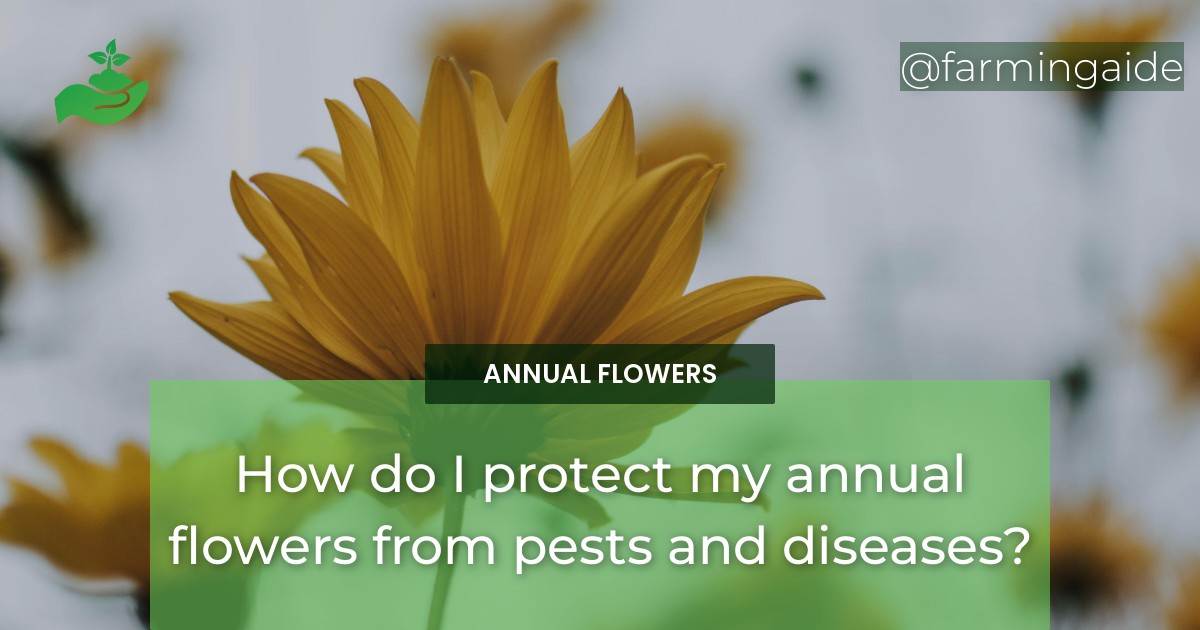Annual flowers are beautiful additions to any garden or landscape. However, they are often vulnerable to pests and diseases, which can ruin their appearance and even kill them. Protecting your annual flowers from pests and diseases requires knowledge of common issues and proactive measures to prevent and address them.
Common Pests and Diseases that Affect Annual Flowers
Pests
Aphids
Aphids are tiny insects that suck the sap from plants, causing leaves to curl and yellow. They reproduce quickly and can spread diseases.
- Use a strong stream of water to knock aphids off plants.
- Release natural predators, such as ladybugs or lacewings.
- Apply insecticidal soap or neem oil.
Spider Mites
Spider mites are too small to see without a magnifying glass. They feed on the underside of leaves and cause them to yellow and fall off. They spin webs on plants and can infest an entire garden fast.
- Use a strong stream of water to knock spider mites off plants.
- Release natural predators, such as ladybugs or lacewings.
- Apply insecticidal soap or neem oil.
Thrips
Thrips are tiny insects that feed on flower buds, causing them to deform and lose color. They can also spread viruses.
- Remove and destroy affected flowers.
- Apply insecticidal soap or neem oil.
Mealybugs
Mealybugs are soft-bodied, white insects that produce a sticky substance, attracting ants and promoting the growth of sooty mold. They can quickly spread to other plants.
- Use a cotton swab dipped in alcohol to remove mealybugs.
- Release natural predators, such as ladybugs or lacewings.
- Apply insecticidal soap or neem oil.
Whiteflies
Whiteflies are tiny white insects that suck sap from leaves, causing them to yellow and fall off. They can also spread viruses and secrete honeydew, attracting ants and promoting the growth of sooty mold.
- Use a strong stream of water to knock whiteflies off plants.
- Release natural predators, such as ladybugs or lacewings.
- Apply insecticidal soap or neem oil.
Diseases
Powdery Mildew
Powdery mildew is a fungal disease that appears as a white or gray powdery coating on leaves and stems. It thrives in humid conditions and can stunt growth and reduce flower production.
- Avoid overhead watering.
- Prune affected parts of the plant.
- Treat with a fungicide.
Botrytis Blight
Botrytis blight is a fungal disease that affects flowers, causing them to rot and turn brown or gray. It spreads quickly in humid conditions and can kill entire plants.
- Remove infected plant parts.
- Avoid overhead watering.
- Treat with a fungicide.
Fusarium Wilt
Fusarium wilt is a fungal disease that affects the roots of plants, causing them to wilt and die. It spreads quickly in warm, moist conditions.
- Remove affected plants and soil.
- Rotate crops.
- Treat with a fungicide.
Root Rot
Root rot is a fungal disease that affects the roots of plants, causing them to rot and die. It is caused by overwatering and poor drainage.
- Improve soil drainage.
- Avoid overwatering.
- Use a fungicide.
Methods for Prevention, Identification, and Treatment
Prevention
Proper Plant Selection and Placement
Choose plants that are resistant to common pests and diseases in your area. Plant them in areas with good soil drainage and adequate sunlight and air circulation.
Soil Health Maintenance
Maintain soil health by adding organic matter and using natural fertilizers. Healthy soil promotes strong plant growth, making them more resistant to pests and diseases.
Avoiding Overcrowding
Plant annual flowers with enough space between them to promote good air circulation and prevent crowding. Overcrowding can lead to poor plant growth and increase the risk of pests and diseases.
Regular Inspection and Maintenance
Regularly inspect your plants for signs of pests and diseases, and promptly address any issues. Remove dead plant parts, weeds, and debris from around plants to reduce the risk of pests and diseases.
Identification
Visual Symptoms
Learn to recognize the visual symptoms of common pests and diseases affecting annual flowers, such as yellowing leaves, wilting, or abnormal growth.
Physical Examination
Inspect plants physically by checking for the presence of insects, webs, or fungal growth. Collect samples for identification by a professional if needed.
Treatment
Organic Solutions
Use organic solutions, such as insecticidal soap, horticultural oils, or neem oil. They are safe for humans and beneficial insects and are less toxic than chemical solutions.
Chemical Solutions
Use chemical solutions as a last resort and only as directed. They are toxic to humans, pets, and beneficial insects and can harm the environment.
Integrated Pest Management (IPM)
Implement an Integrated Pest Management program that combines prevention, identification, and treatment methods to reduce the risk of pests and diseases and minimize their impact on plants and the environment.
Can Shaded Areas Increase the Risk of Pests and Diseases for Annual Flowers?
Planting the best shade annual flowers can create a beautiful garden, but shaded areas may increase the risk of pests and diseases for these plants. Adequate air circulation and proper maintenance are essential to prevent these issues. Be mindful of watering and avoid over-fertilizing to keep your annual flowers healthy.
Conclusion
Protecting your annual flowers from pests and diseases requires proactive measures, including proper plant selection and placement, soil health maintenance, avoiding overcrowding, and regular inspection and maintenance. Learn to identify common pests and diseases affecting annual flowers and use organic or chemical solutions and Integrated Pest Management techniques to address them effectively. With these methods, you can enjoy beautiful and healthy annual flowers all season long.


